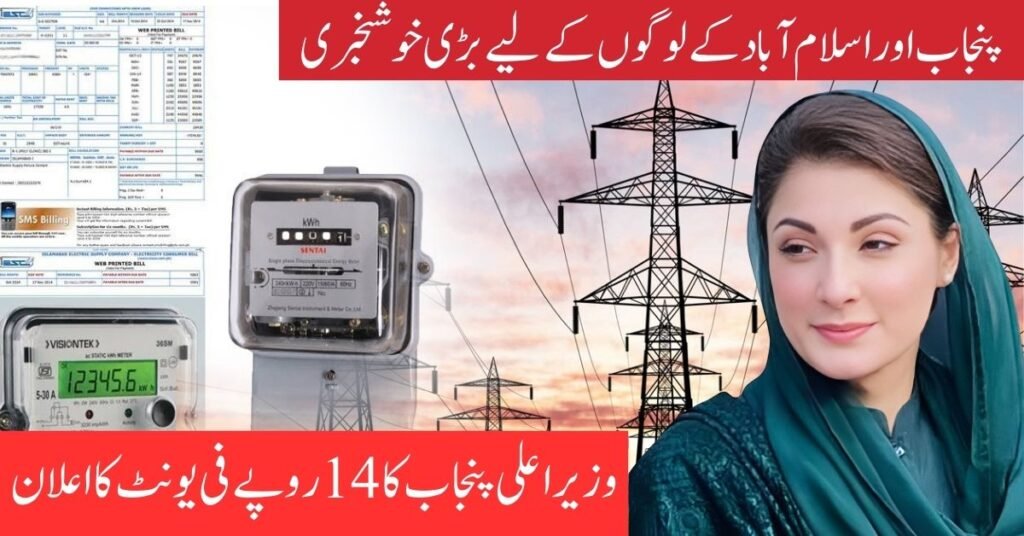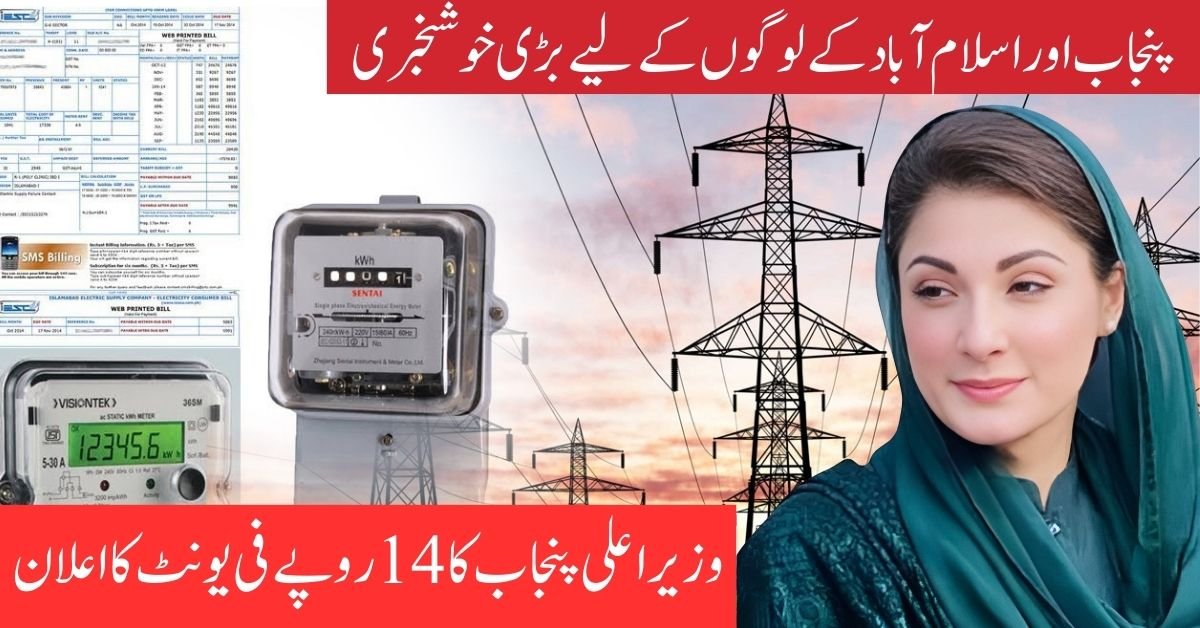Discover how Punjab’s Rs. 14/unit electricity relief benefits specific consumers. Find out which power companies are involved and the subsidy’s impact.
Punjab Electricity Relief
The Punjab government, under the leadership of Chief Minister Maryam Nawaz Sharif, has taken a significant step to ease the burden of electricity bills for consumers. A special relief of Rs. 14 per unit has been announced for those using between 200 and 500 units of electricity. This relief, however, is not universal but targeted, benefiting only a limited number of consumers within Punjab and Islamabad.
Understanding the Electricity Relief Initiative
What is the Punjab Electricity Relief?
In response to the rising electricity costs, the Punjab government has introduced a subsidy that offers a reduction of Rs. 14 per unit for electricity consumption falling between 200 to 500 units. This initiative aims to provide some financial respite to the consumers amidst escalating energy prices.
Why Only Limited Consumers?
It’s crucial to note that this subsidy is not for everyone. The relief targets a specific group of consumers who fall within the 200-500 unit consumption bracket. This decision likely stems from budgetary constraints and the need to provide focused assistance rather than a broad-based subsidy.
Who Will Benefit from the Relief?
Eligibility Criteria
To qualify for this relief, consumers must meet the following conditions:
- Location: The relief applies to electricity consumers in Punjab and Islamabad.
- Consumption Range: Only those who consume between 200 and 500 units per month are eligible.
- Electricity Providers: The relief is applicable if the consumer’s electricity provider is one of the five specified companies.
The Five Electricity Companies Involved
Chief Minister Maryam Nawaz Sharif has sent formal letters to the following electricity companies to implement this subsidy:
- IESCO (Islamabad Electric Supply Company)
- MEPCO (Multan Electric Power Company)
- GEPCO (Gujranwala Electric Power Company)
- FESCO (Faisalabad Electric Supply Company)
- LESCO (Lahore Electric Supply Company)
These companies are now tasked with adjusting their billing to reflect the Rs. 14 per unit relief for eligible consumers.

Impact and Implications of the Relief
Financial Impact on the Government
The implementation of this subsidy will have financial implications for the Punjab government. The government will cover the difference between the original bill and the subsidized amount, which could strain the provincial budget. The exact cost of this initiative is yet to be determined, as the involved companies have been asked to submit their cost estimates.
Limited Reach and Its Consequences
While this initiative is commendable, its limited reach is a point of contention. Official data indicates that only 14% of the nation’s electricity consumers use more than 200 units per month. This means that the vast majority, approximately 86%, do not benefit from this relief. This raises questions about the overall effectiveness of the subsidy in addressing the broader issue of high electricity costs.
Breakdown of Electricity Consumption in Punjab and Islamabad
General Consumption Patterns
Electricity consumption varies significantly across different regions and demographics in Punjab and Islamabad. The bulk of the population consumes less than 200 units per month, primarily due to economic constraints and energy-saving practices.
Who Falls Between 200-500 Units?
Consumers in the 200-500 unit range often represent middle-income households that use electricity for basic needs, such as lighting, fans, and essential appliances. They might also include small businesses that have moderate energy requirements.
The Role of Provincial Governments in Electricity Subsidies
Subsidy Mechanisms
Provincial governments can influence electricity pricing by offering subsidies to specific consumer groups. These subsidies are generally financed through provincial budgets and are aimed at mitigating the impact of rising electricity tariffs.
Challenges in Implementation
Implementing such subsidies comes with its own set of challenges. Firstly, there is the issue of accurate targeting—ensuring that only the eligible consumers benefit from the subsidy. Additionally, the financial burden on the provincial government can be significant, especially if the subsidy is extended over a prolonged period.
The Bigger Picture: Energy Costs and Subsidies in Pakistan
Rising Electricity Prices
Electricity prices in Pakistan have been on the rise due to several factors, including increased production costs, reliance on imported fuel, and infrastructural inefficiencies. These rising costs have had a direct impact on consumers, leading to higher electricity bills.
Subsidies as a Short-Term Solution
While subsidies like the Rs. 14 per unit relief can provide temporary relief, they are not a long-term solution to the problem of high energy costs. The government needs to address the root causes, such as improving energy efficiency, investing in renewable energy, and reducing reliance on costly imported fuel.
Consumer Reactions and Feedback
Public Sentiment
The public reaction to this relief has been mixed. While those eligible for the subsidy are appreciative, others feel left out. The limited scope of the relief has led to frustration among consumers who use less than 200 units and do not benefit from the subsidy.
Consumer Advocacy Groups’ Perspective
Consumer advocacy groups have voiced concerns about the fairness of the subsidy. They argue that a more inclusive approach is needed to ensure that a larger portion of the population benefits from such initiatives.
Future of Electricity Subsidies in Punjab
Potential Expansions
There is speculation that the government might consider expanding the subsidy to include a broader range of consumers in the future. However, this would require careful consideration of the financial implications and the sustainability of such a move.
Long-Term Strategies
For a more sustainable solution, the government may need to explore alternative strategies, such as investing in energy efficiency programs, encouraging the use of renewable energy, and reforming the electricity tariff structure.
How to Maximize the Benefit of the Subsidy
Energy-Saving Tips for Consumers
Consumers who are eligible for the subsidy can maximize their benefits by adopting energy-saving practices:
- Use energy-efficient appliances: These consume less electricity and can help keep usage within the subsidized range.
- Turn off appliances when not in use: Simple actions like turning off lights, fans, and electronics can make a significant difference.
- Consider solar energy options: Installing solar panels can reduce reliance on grid electricity and lower overall consumption.
Monitoring Your Electricity Usage
Keeping track of electricity usage is crucial. Consumers can regularly check their meters and bills to ensure they stay within the 200-500 unit range, thereby fully benefiting from the subsidy.
What’s Next for the Punjab Government?
Government’s Future Plans
The Punjab government is likely to continue exploring ways to support consumers in the face of rising electricity costs. Future initiatives could include more targeted subsidies, infrastructure improvements, or incentives for renewable energy adoption.
Continuous Monitoring and Feedback
The success of the current subsidy will be closely monitored, with consumer feedback playing a key role in shaping future policies. The government may adjust the program based on the feedback received and the financial viability of the subsidy.
Conclusion: A Step in the Right Direction
The Rs. 14 per unit electricity relief introduced by the Punjab government is a step towards addressing the financial strain caused by high electricity costs. While its impact is limited to a specific group of consumers, it provides much-needed relief to those who fall within the 200-500 unit consumption range. However, the broader issue of high energy costs remains, and further measures will be needed to provide comprehensive support to all consumers.
FAQs
- Who is eligible for the Rs. 14 per unit electricity relief?
- Consumers in Punjab and Islamabad who use between 200 and 500 units of electricity per month are eligible for this subsidy.
- Which electricity companies are involved in this initiative?
- The subsidy applies to consumers served by IESCO, MEPCO, GEPCO, FESCO, and LESCO.
- How long will this subsidy be available?
- The duration of the subsidy has not been specified. It is expected to apply to the August and September bills, but further details will depend on government policy.
- Why doesn’t the subsidy apply to all consumers?
- Due to budget constraints, the subsidy is targeted at a specific group of consumers to provide focused relief rather than a broad-based subsidy.
- Will the government expand the subsidy to include more consumers?
- While there is speculation about potential expansion, no official announcements have been made. The government will likely evaluate the program’s success before making further decisions.

